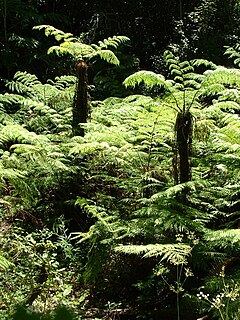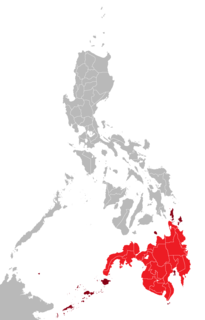
Cyathea cooperi, also known as the Australian tree fern, lacy tree fern, scaly tree fern, or Cooper's tree fern, is a tree fern native to Australia, in New South Wales and Queensland.

The Cyatheaceae are the scaly tree fern family and include the world's tallest tree ferns, which reach heights up to 20 m. They are also very ancient plants, appearing in the fossil record in the late Jurassic, though the modern genera likely appeared in the Cenozoic. Cyatheaceae are the largest family of tree ferns, including about 500 species. Cyatheaceae and Dicksoniaceae, together with Metaxyaceae and Cibotiaceae, are a monophyletic group and constitute the "core tree ferns". Cyatheaceae are leptosporangiate ferns, the most familiar group of monilophytes.
Cyathea affinis is a variable species of tree fern native to Fiji, Samoa, the Cook Islands, Austral Islands, Tahiti, and the Marquesas Islands. The trunk of this plant is erect and 2–6 m tall. Fronds are bipinnate and 2–3 m in length. The rachis and stipe are pale to brown in colour, or flushed with red towards the pinnule rachis. The stipe is sparsely covered in narrow basal scales, which are pale to dark and have broad fragile edges. Characteristically of this species, the lowest one or two pairs of pinnae may be slightly reduced and occur towards the base of the stipe. Sori are located near the pinnule midvein and are partially or fully covered by indusia, which open towards the pinnule margin.
Cyathea acrostichoides is a species of tree fern native to the Maluku Islands and Western New Guinea, where it grows in forest and disturbed sites at an altitude of 650–1100 m. The trunk is erect and usually 1–3 m tall. Fronds are bipinnate and 1–2 m long. The stipe is slender and covered with spines. It is sparsely covered with medium brown scales. Sori cover most of the underside of fertile pinnules. C. acrostichoides lacks indusia.
Cyathea apiculata is a species of tree fern native to Sumatra, where it grows in montane rain forest at an altitude of about 1800 m. The trunk is erect and usually 5 m tall or more. Fronds are bi- or tripinnate and 2–3 m long. The stipe is pale, becoming darker towards the base. It is covered with dark scales with pale, fragile edges. Sori occur near the midvein of fertile pinnules and are covered by thin, very fragile indusia.
Cyathea baileyana, also known as the wig tree fern, is a species of tree fern native to northeastern Queensland in Australia, where it grows in wet gullies and forest at an altitude of 850–1200 m. It is a rare species that is seldom found in the wild. The erect trunk is 4–5 m tall, approximately 10 cm in diameter and may be covered in stipe bases in the upper regions. C. baileyana is notable for being able to develop offshoots from the base of the trunk. Fronds are bi- or tripinnate and may be exceptionally long, up to 7 m, though they are usually around 2–3 m. The rachis and stipe are dark to darkish red, scaly and may be warty, but lack spines. Scales on the rachis and stipe are purplish brown to black and have a long hair-like apex. Characteristically of this species, the last pair of pinnae are separated from the others along the rachis and may form a clump around the trunk apex. Sori are circular and occur in one to three rows along the pinnule midvein. They lack indusia.
Cyathea brooksii is a species of tree fern native to Cuba, Hispaniola and Puerto Rico, where it grows on serpentine soils in shaded ravines, along streams, and on forested slopese at an altitude of 250–950 m. The trunk is prostrate and only about 6 cm in diameter. Fronds are pinnate or bipinnate and up to 2 m long. The base of the rachis is covered with blackish scales that have a paler margin. Sori occur in two rows, one along each side of the pinnule midvein.

Cyathea capensis is a regionally widespread and highly variable species of tree fern. It is indigenous to Southern Africa and South America.
Cyathea caudata is a species of tree fern native to the islands of Luzon and Mindanao in the Philippines, where it grows in montane forest. The trunk is erect and up to 4 m tall or more. Fronds are bi- or tripinnate and 1–2 m long. The stipe is warty and covered with dark, narrow, glossy scales. Sori are borne near the midvein of fertile pinnules and are protected by firm, brown indusia.
Cyathea costulisora is a species of tree fern native to Sumatra. The trunk is erect and usually 1–4 m tall. Fronds are bi- or tripinnate and 1–2 m long. The stipe is covered with warts and scales. The scales are either pale and glossy or dark and flat. Sori occur near the fertile pinnule midvein and are covered by large, firm, brown indusia.

Cyathea cunninghamii, also known as the gully tree fern and slender tree fern, is a species of tree fern indigenous to New Zealand including North Island, South Island and Chatham Islands; also to Victoria, possibly New South Wales, southeastern Queensland and Tasmania in Australia. It grows in damp forest, often emerging from stream gullies and riverbanks. Brownsey noted that it has a lower tolerance for drought than other species of Cyathea. The erect trunk may be 20 m tall and is usually 6–15 cm in diameter, occasionally as much as 20 cm. Fronds are tri- to tetrapinnate and 3 m or more in length. The rachis and stipe are slender, black brown, warty and covered with brown scales. Sori occur along each side of the pinnule midvein and are covered by hood-like indusia. C. cunninghamii is an uncommon and slow-growing tree fern.

Cyathea dregei is a widespread species of tree fern in southern Africa.
Cyathea edanoi is a species of tree fern endemic to Luzon in the Philippines, where it grows in montane forest at an altitude of about 1300 m. The trunk is erect and 1–2 m tall. Fronds are bi- or tripinnate and approximately 1 m long. The stipe is covered in dark, glossy scales that have narrow, fragile edges. Sori occur near the midvein of fertile pinnules and are covered, sometimes half-covered, by large, firm, brown indusia.
Cyathea squamulata is a species of tree fern native to the Malay Peninsula, Sumatra, Java, Borneo and the southern Philippines, including the Sulu Archipelago, where it grows in forest from the lowlands to an altitude of about 1500 m. The trunk is erect and up to 2 m tall. Fronds are pinnate or bipinnate and approximately 1.5 m long. The stipe is covered in densely packed firm, medium brown scales. Sori occur near the fertile pinnule midvein and lack indusia.
Cyathea × marcescens, commonly known as the skirted tree fern, is a tree fern endemic to the Cape Otway ranges in Victoria and Tasmania, Australia. It is a natural hybrid, apparently Cyathea australis × Cyathea cunninghamii. Braggins and Large (2004) note that it has characteristics midway between these two species. The spores of C. × marcescens are usually malformed although sterile. The trunk of this plant is erect and up to 10 m tall. Fronds may be bi- or tripinnate and 3–4 m in length. Dead fronds often persist, forming a characteristic skirt around the trunk. The stipe is thick, black and warty. The rachis and trunk are covered in shiny, dark brown scales. Sori are borne near the fertile pinnule midvein and are protected by thin indusia that are saucer-like in appearance.
Cyathea hotteana is a species of tree fern endemic to Haiti, where it grows in cloud forest at an altitude of 1000–1200 m. The trunk of this plant is erect, up to 2 m tall, and approximately 8 cm in diameter. Fronds are pinnate and may reach 2 m in length. Brown basal scales cover the rachis and stipe, which are also brown. Sori are borne in two rows, one on each side of the pinnule midvein. They are covered by shallow, plate-like indusia, which bear one or two clefts at the margin.
Cyathea kermadecensis is a species of tree fern endemic to Raoul Island in the Kermadec Islands, where it is locally common in damp, and sometimes drier, forest and scrub. The trunk of this plant is erect, slender, and up to 20 m tall. It is often covered with scars of old stipe-bases. Fronds are tripinnate and up to 4 m in length. The rachis and stipe are both brown in colouration and bear basal scales that are brown, glossy, and often twisted. Sori are borne on either side of the pinnule midvein. They are covered by hood-like indusia.
Alsophila is a section in the subgenus Cyathea. The name was originally applied to a genus of tree ferns which is now considered to be synonymous with Cyathea.

Cyathea smithii, commonly known as the soft tree fern or kātote, is a species of tree fern from New Zealand.









